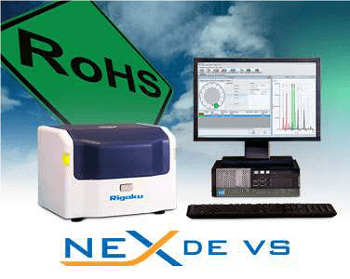Applied Rigaku Technologies, Inc. has announced a new empirical method for the measurement of toxic elements in plastics by energy dispersive X-ray fluorescence (EDXRF).
 Rigaku NEX DE VS variable spot size EDXRF spectrometer with QuantEZ software
Rigaku NEX DE VS variable spot size EDXRF spectrometer with QuantEZ software
Rigaku EDXRF Application Note #1602 describes the measurement of chromium (Cr), mercury (Hg), lead (Pb), bromine (Br) and cadmium (Cd) in polyethylene (PE), and demonstrates the performance of the Rigaku NEX DE VS EDXRF spectrometer.
The Restriction on Hazardous Substances initiative (RoHS) limits the allowable amounts of toxic elements in plastics and consumer goods. Energy dispersive X-ray fluorescence is an established analysis technique for rapid screening and quantification of the hazardous elements according to RoHS norms. For the analysis detailed in this report, measurement was performed using the NEX DE VS analyzer equipped with automatic collimators and a camera for sample positioning and imaging. The unit is designed to give QA/QC technicians a means for fast, simple screening and analysis of materials that must conform to RoHS and similar directives. The new application report includes information about method calibration and sensitivity validation, as well as details about the instrument’s RoHS software and reporting.
The results detailed in the report show outstanding performance by the NEX DE VS analyzer, which provides exceptional sensitivity and reliable precision for RoHS rapid screening by EDXRF down to 1 mm spot size.
A copy of this application report may be requested on Rigaku’s EDXRF website: